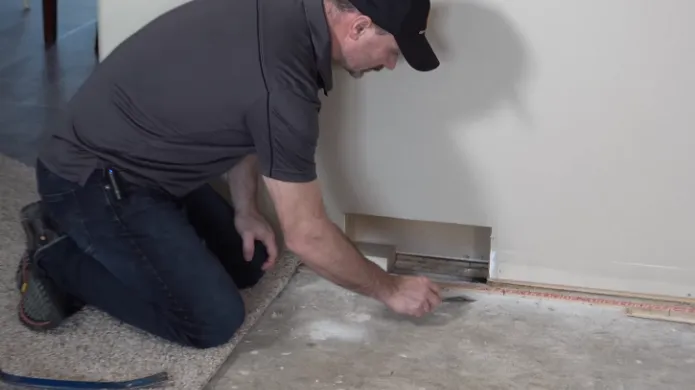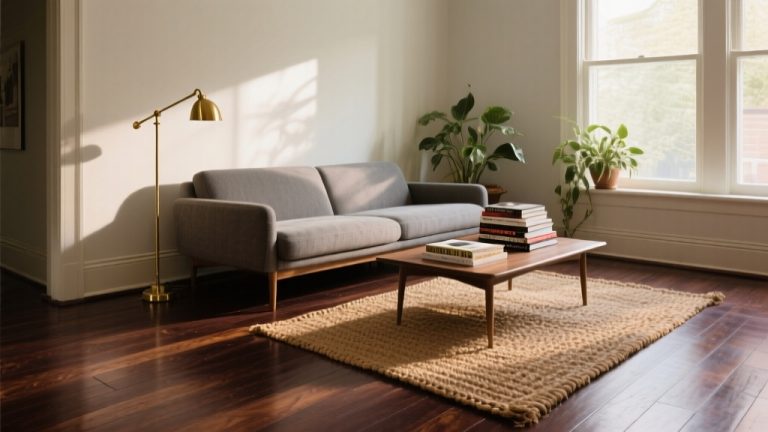How to Match Engineered Hardwood Floors
Matching engineered hardwood floors is not always easy, but with a little guidance and know-how, you can create a harmonious and cohesive look in your home. To achieve this, you must consider several factors such as color, texture, and finish.
You’ll want to match your existing engineered hardwood floors by gathering samples with different intensities. To avoid clashes between your new and old floors, you need to find the right match. However, if you want a more seamless look, you should strip your hardwood floors and refinish them.
As we proceed through this article, we will examine what factors to consider when matching engineered hardwood floors.
How to Match Engineered Hardwood Floors: Some Useful Considerations
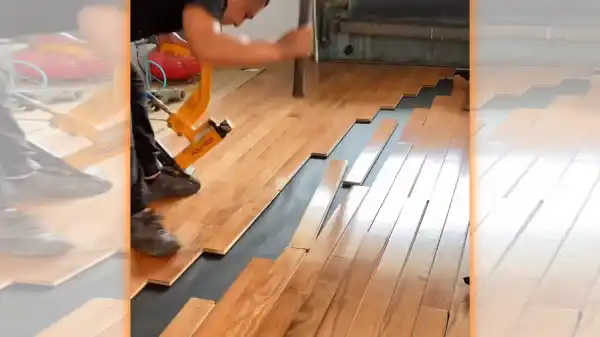
When matching engineered hardwood floors, you should consider several factors to achieve a cohesive look. These factors will help create a stunning and harmonious space with engineered hardwood floors.
- Determine the Type and Style:
- Consider the Thickness:
- Evaluate the Wood Species:
- Assess the Grain Patterns and Texture:
- Pay Attention to Color Matching:
- Refinishing and Staining Options:
- Utilize Transition Strips:
1. Determine the Type and Style:
Identifying the species, grade, color, surface finish, and plank width of your existing engineered hardwood floor is key to finding a suitable match that fits seamlessly with the type and style of your current flooring.
When determining the type and style of your flooring, consider the following:
- Species: The species of wood used in your existing flooring affects its color and texture. For example, oak has a distinctive grain pattern and light to medium brown color, while maple has a more uniform, pale color.
- Grade: The grade of the wood refers to its quality and appearance. Higher grades, such as clear or select, have fewer knots and blemishes, while lower grades, such as rustic or character, have more natural imperfections.
- Color: The color of your existing flooring can be warm or cool, light or dark. Consider whether you want to match the color exactly or choose a complementary shade.
- Surface finish: The surface finish of your flooring can be glossy, matte, or somewhere in between. Matching the finish can help your new flooring blend seamlessly with the old.
2. Consider the Thickness:
When matching engineered hardwood floors, aim for the same thickness throughout the space. Even slight variations in thickness can lead to an uneven surface, which can cause tripping hazards and make furniture placement difficult.
If an exact match in thickness is unavailable, flooring professionals can help determine the best approach for addressing variations. Options may include adding a layer of underlayment or sanding down the existing flooring to create a level surface.
3. Evaluate the Wood Species:
To make your flooring pop, evaluate the wood species used in your current flooring and find a complementary option to take your home’s aesthetic to the next level. Here are some things to consider when evaluating wood species:
- Look for species with grain patterns and colors similar to your existing flooring.
- Consider the durability and hardness of the species, especially if you have high-traffic areas in your home.
- Think about the overall style and theme of your home. For example, if you have a rustic or farmhouse style, you may want to choose a distressed or hand-scraped wood.
- Remember the environmental impact of the wood species. Look for options that are sustainably sourced and eco-friendly.
4. Assess the Grain Patterns and Texture:
When matching engineered hardwood floors, the grain pattern, and texture are crucial in creating a cohesive and unified appearance. Assess the existing floor and search for replacement options with similar patterns and textures to blend seamlessly with the rest of the room.
Grain patterns refer to the natural lines and swirls that form on the surface of the wood. Each wood species has a unique grain pattern, and it’s essential to match the replacement wood with the existing floor to create an appealing aesthetic.
The texture is another factor to consider, as it’s the surface quality of the wood. Smooth, brushed, and distressed textures are common in engineered hardwood floors. Evaluate the texture of the existing floor and choose a replacement option with a similar texture to avoid any visual differences.
5. Pay Attention to Color Matching:
Matching the color of your new engineered hardwood floors to your existing flooring is crucial to achieving a cohesive and seamless look throughout your home. Here are some factors to consider when color matching:
- Take note of the intensity of the color of your existing flooring and look for a similar intensity in your replacement option.
- Assess the warmth of your current flooring and select a similar replacement.
- Pay attention to the undertones in your existing flooring and try to find a replacement option with similar undertones to ensure a good match.
- Observe the lighting in your home, as it can significantly affect the appearance of your flooring. Test your new flooring samples in different lighting conditions to ensure a good color match.
6. Refinishing and Staining Options:
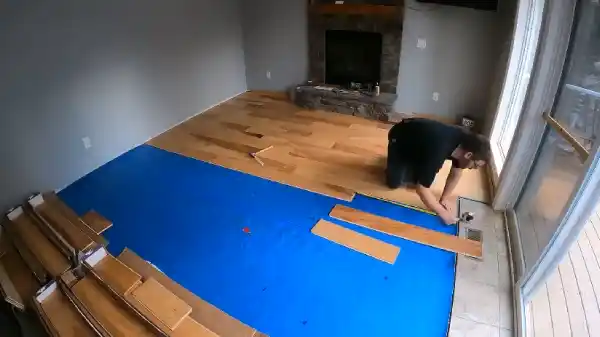
Refinishing and staining your existing and new boards can provide a solution that fits your home’s style. This option allows you to customize the color of your flooring and achieve a seamless transition between the old and new boards.
When refinishing the flooring, you must sand down the existing and new boards to remove any previous finishes and stains. This process will make the wood surface even and provide a clean slate for applying the new stain.
Staining the boards will help match the color of the existing flooring and create a cohesive look throughout your home. It’s important to consult professionals to ensure that the color matches perfectly and the refinishing process is done correctly.
7. Utilize Transition Strips:
To seamlessly blend different flooring areas with varying heights and colors, you can complement the overall design of your home by utilizing transition strips and ensuring proper installation.
Transition strips serve as a bridge between two different flooring areas, and they can help create a smooth and cohesive look throughout your home.
Here are three reasons why transition strips are a smart choice for matching engineered hardwood floors:
- Height Differences: Transition strips can be used to handle height differences between two areas of flooring.
- Changes in Direction: These strips can also handle direction changes between two flooring areas.
- Blending Colors: You can blend colors between two flooring areas with these strips.
Can you put two different wood floors next to each other?
Mixing two different hardwood floors together is like blending different spices in a recipe – it can create a unique and tasteful result if done correctly. However, some things should be considered before mixing and matching your floors.
One important factor to keep in mind is the size of the rooms. If the rooms are small, using two different wood floors may make them look cluttered and overwhelming. Conversely, mixing different wood floors can help break up the space and add visual interest if the rooms are large.
Another thing to consider is the color and texture of the floors. You want to ensure that the two wood floors complement each other and do not clash. A good way to achieve this is using transition strips between the two floors. These strips can help create a seamless transition between the two floors while adding a design element.
Is it OK to have different colored hardwood floors in different rooms?
It’s perfectly fine to have different hardwood flooring colors in separate rooms as long as you maintain a sense of harmony and balance throughout your home.
One way to achieve this is by choosing a central flooring material that can be used in all the rooms of your home. This will create a sense of synergy and flow throughout your living space.
However, if you want to use different color hardwood floors in different rooms, you can still achieve a cohesive look by choosing colors that complement each other. For example, you can use darker shades in high-traffic areas like the entryway or living room and lighter shades in the bedrooms or hallway.
Can I replace one plank of engineered hardwood floors?
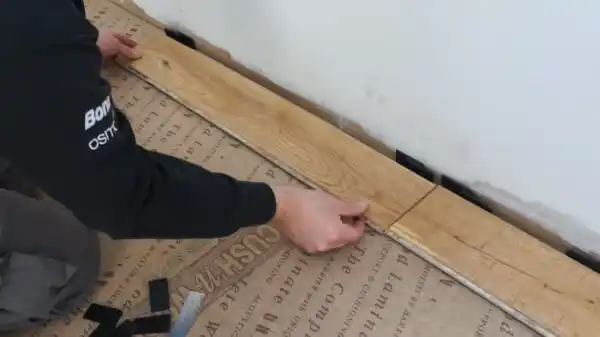
If you’re dealing with a damaged board in your engineered hardwood flooring, it’s easy to replace. Experienced fitters can do this for you effectively. However, if you’re feeling ambitious and are comfortable with DIY projects, you can replace the plank yourself.
What color hardwood floor makes a room look bigger?
Opting for lighter-colored hardwood flooring can create the illusion of a larger room and make it feel more open and airy.
Lighter colors such as whites, creams, and natural tones can reflect more light, making the space brighter and more expansive. This can be especially beneficial for smaller rooms or those with less natural light.
In addition to color, the plank size and direction can also impact the perceived size of a room. Choosing wider planks can make a room appear more spacious while laying them in a diagonal direction can create the illusion of even more space.
Should flooring be lighter or darker than furniture?
Creating a harmonious balance between the color of your furniture and hardwood flooring is crucial in achieving a cohesive and aesthetically pleasing space. When choosing the color of your flooring, consider the weight of your furniture.
Lighter floors tend to go well with delicate pieces of furniture, while darker woods are a better match for heavier pieces. By choosing a lighter floor for more delicate furniture, you can create a sense of airiness and openness in the space. This can help to make the room appear larger and more inviting.
Match Engineered Hardwood Floors to Create a Beautiful Look with Cohesive Flooring
Whether replacing a single plank or installing new flooring throughout your home, matching can create a beautiful and harmonious look. Now that you understand some useful considerations, such as color and plank replacement, you can confidently create a cohesive look throughout your home.
For a more polished, put-together appearance, stick with a consistent look rather than mixing and matching different wood floors or colors. Also, choosing the right hardwood flooring color can make a room appear larger and more inviting.
So go ahead and put your newfound knowledge to the test.


